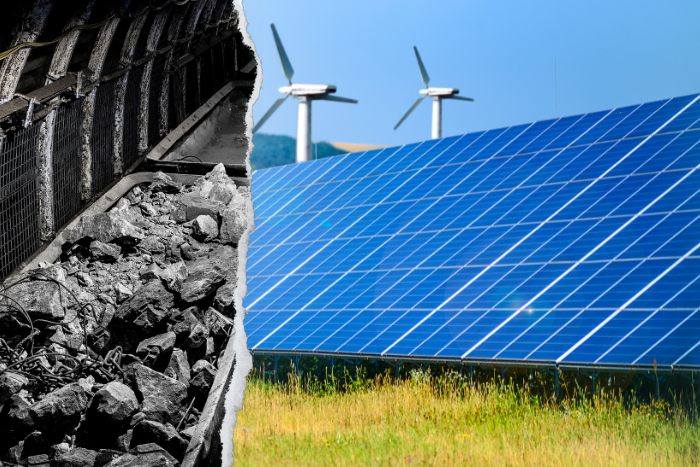Solar power was the dominant renewable energy, accounting for six out of 11 deals, or 40% of financing, says the report
While India did not sign the pledge to triple renewable energy globally by 2030 at COP28, a recent report found that for the second year in a row, no coal power plant has received project finance lending in the country in 2022.
An analysis authored by Centre for Financial Accountability (CFA) and Climate Trends indicated that lenders preferred financing renewable energy projects over coal. The report found that all energy projects that reached financial closure for project finance lending in 2022 were renewable energy projects. On the flip side, it also showed a 45% reduction in project finance to renewable energy.
The 2023 Coal vs Renewables Investment Report looked at 68 project finance loans across 11 coal and renewable energy projects in India that reached financial closure between January 1, 2022, and December 31, 2022.
While renewable energy projects are defined as hydroelectric, geothermal, wave, wind, or solar power projects, this report looked at wind and solar project finance loans only. Total project finance loans amounted to ₹18,577 crore ($2.36 billion), of which 100% flowed into renewable energy projects. However, the total amount is a 45% decrease from 2021 levels. This could be a result of several external factors such as project delays due to the pandemic, supply line disruptions, increase in costs of finance due to higher interest rates as well as increased costs due to domestic policies.
Solar dominates
Like last year, solar power was the dominant renewable energy, accounting for six out of 11 deals, or 40% of financing. However, the report found solar lending in 2022 dropped by over 64% to ₹7,361 crore ($935 million), financing 1,849 megawatts (MW) of solar projects.
Wind power comprised only 4% of total renewable energy lending in 2022, financing two projects equalling 144 MW of wind energy. This represents a more than 80% decrease compared to 2021.
Cost effective
The data in the report suggested that any new coal power plant, irrespective of location, will be unable to supply power at less than ₹5/kWh. In contrast, figures from recent stand-alone RE (solar PV or onshore wind) from the same time period range between ₹2 to 3.5/kWh.
“Tariffs from recently commissioned coal plants demonstrate that renewables paired with storage is now competitive, if not the cheaper option, to deliver round the clock power. Most new coal plants are being built by government sector entities and not the private sector, for a reason. Even pithead coal plants are struggling to compete on cost with round the clock renewable bids coming in the ₹3-4/kWh range. Storage costs will fall further as India ramps up investments in battery technology, even as coal costs rise. The financial case for new coal plants continues to grow weaker, for both investors and power consumers,” said Ashish Fernandes, CEO, Climate Risk Horizons.
Where’s the money coming from?
According to the report, the majority of loans came from commercial banks, totalling five deals and 68% of overall funding. Commercial lending for renewable projects decreased by 51% from 2021 levels. The Coöperatieve Rabobank UA was the largest lender, with a loan totalling ₹7,749 crore ($985 million). This loan outperformed the largest renewables loan of 2021, provided by L&T Finance, which was ₹4,214 crore ($ 565 million).
“Cost of renewable energy with storage is now comparable and cheaper than new coal plant construction, irrespective of the location. Besides losing out to renewable energy on per unit cost of electricity, coal power plants will have to be retired within a decade from now. Financial institutions are reluctant to fund coal projects, be it power plant construction or coal mining, knowing fully well that the global outlook on coal remains heavily in the negative”, said Joe Athialy, executive director, CFA.
The report also added that primary financing—funding allocated to construct new projects—continued to dominate the project financing landscape in India. Over 85% of all deals were categorised as primary financing deals, with refinancing constituting the remaining 15%.
Like in 2021, Rajasthan was the biggest beneficiary of renewable energy lending compared to other Indian states, with over ₹7,579 crore ($963 million).
India has already installed close to 132 GW of renewable energy from its earlier target of 175 GW and yet is determined to make additional power demand be met by renewables where possible.
The report recommended that as financial institutions reduce their investments in coal projects, policy and regulations must also ensure more funds flow towards renewable energy projects.
About The Author
You may also like
Clean Energy Push Would Halve Warming Rate by 2040: Report
Renewable is elbowing out coal: Can it continue the growth momentum?
Rising Global Energy Demand Fuel Security Threats: WEO Report
PMSGY Drives Rooftop Solar Expansion, But Challenges Remain: Report
Global Renewable Energy Capacity to Double by 2030, Led by Solar PV: Report

